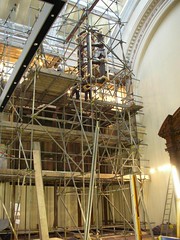By Stuart Frost
 A remarkable amount of work has been going behind the hoardings in the Museum and away from the public gaze elsewhere. In fact there is so much activity taking place that its impossible to mention it all here.
A remarkable amount of work has been going behind the hoardings in the Museum and away from the public gaze elsewhere. In fact there is so much activity taking place that its impossible to mention it all here.
There is an increasing amount of effort going into the creation of new content for the website with a large number of colleagues across the V&A contributing. Much of this will only go online when the new Medieval and Renaissance Galleries open in 2009.
However we have just added three subjects to the website highlighting recently completed work on a trio of very different objects. These online-only subjects provide short summaries of projects that were extremely complex and which involved wide-ranging specialist expertise.
 Stephanie Seavers, part of the curatorial team in the Metalwork department, has produced a summary of a collaborative research project that focussed on a beautiful twelfth-century enamelled container previously thought to be a reliquary from Cologne. The image I’ve used here, above and to the right, gives a wonderful impression of just how rigorously and carefully the object was examined. Enamelled panels have been removed exposing the wooden core.
Stephanie Seavers, part of the curatorial team in the Metalwork department, has produced a summary of a collaborative research project that focussed on a beautiful twelfth-century enamelled container previously thought to be a reliquary from Cologne. The image I’ve used here, above and to the right, gives a wonderful impression of just how rigorously and carefully the object was examined. Enamelled panels have been removed exposing the wooden core.
Nick Humphrey, a curator in the Furniture, Textiles and Fashion department focussed on the recent deinstallation of the vast timber façade of a town house built around 1600 for the wealthy merchant Sir Paul Pindar. Visitors to the V&A may remember the façade in its previous location in the old Museum shop. However I suspect that many people failed to notice its considerable presence due to the distraction of all the colourful merchandise at eye level. The façade will be reinstalled in a new daylit gallery which in itself will represent another significant technical achievement.
Zoe Allen, a specialist frames conservator in the Conservation section has written about work she undertook on a frame associated with a magnificent panel painting of the Virgin and Child by an artist known as Peregrinus (or Pellegrino di Giovanni). Here there were questions about whether the frame associated with the panel painting really belonged with it. There was also a significant amount of work needed on the frame which had become very fragile and warped over time. You can see the painting minus the frame in the image below.
 I’m very grateful for all the work that colleagues have contributed to the website. We’re hoping to add more online subjects to the website as the project develops. I’ll also continue to use this blog for more updates on object-based work taking place in the Conservation Studios and elsewhere.
I’m very grateful for all the work that colleagues have contributed to the website. We’re hoping to add more online subjects to the website as the project develops. I’ll also continue to use this blog for more updates on object-based work taking place in the Conservation Studios and elsewhere.
Click here to see the recently added content about a Medieval Tabernacle from Cologne.
Click here to see the recently added content about the façade of Sir Paul Pindar’s House.
Click here to see the recently added content about a painting by Peregrinus of the Virgin and Child with Angels.
I am just writing to say how much I enjoy and look forward to your blog. I hope this can be continued for future new developments in the Museum. One of the things I am trying to do is visualise what the Medieval galleries will look like when finished. Would it be possible to print a rough copy of the floor plans for the development? I think this would help to
picture how each of the new rooms fit together and give an idea of what will be in each room.
Hi John,
Thanks for taking the trouble to post a comment. It is always great to get positive feedback from people and its also reassuring to know that people do read the blog! I’ll look into the possibility of adding plans to the Future Plan area of the website at:
http://www.vam.ac.uk/futureplan/projects/med_ren/index.html
Stuart